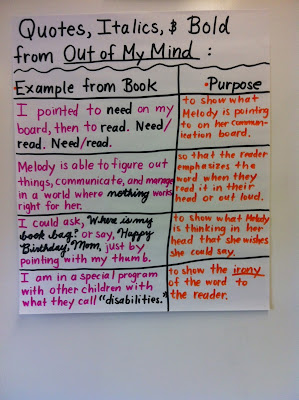Well, we’re back at it again in my district! With summer school that is! We did two weeks of summer school immediately following the school year and are now doing an additional two weeks to get back in the swing of things for the upcoming school year. Me, along with a few of my language arts colleagues, are doing guided reading groups with students reading below grade level. I cannot express how awesome it is to be at work and able to concentrate on ONE thing-guided reading. I’m trying out some cool techniques for fluency that I learned during my LLI conference two weeks ago, and have also really been concentrating on teaching writing conventions through noticing how authors use these conventions in their writing.
Yesterday, I was talking with my group who is reading Out of My Mind by Sharon Draper (yes, I’m a little obsessed with this book), and we were examining reasons that authors use apostrophes in their writing. All of a sudden one of my students in the group said, “Should I be using apostrophes like this too when I write?” I couldn’t help but smile and reply (perhaps with a little too much enthusiasm), “ABSOLUTELY!” It seems silly, but so often at the middle school level we teach students writing and reading separately. It’s so important that students see the two connected. Readers should be noticing what they should do as writers while they’re reading.
Ever since I started teaching using a Reading and Writing Workshop that connected together, I, personally, as a reader, have never looked at reading the same. This summer as I read Gillian Flynn’s three books, Gone Girl, Sharp Places, and Dark Objects, I was constantly thinking about the way she developed her complex characters and the descriptive language she used to create a vision in the reader’s mind of the scene. I know that as I engage in narrative writing with my students this year, my writing will forever be changed by Gillian Flynn.
As teachers, we need to explicitly talk to students about HOW they may use something they learned from their reading about what authors do to apply to their own writing. This is also an awesome way to teach grammar concepts. All of a sudden I have removed myself from being the teacher who stands up in front of the classroom saying, “This is an apostrophe and these are the reasons you use it….” to, “Let’s look at what we read today for how Sharon Draper uses apostrophes in her writing.” Once we’ve found several examples, we can establish the “rules” of apostrophes together based on the examples.
Using this inquiry-based approach to learning important writing conventions through our reading has really taught me, as a teacher, that students learn best when they discover and create the meaning on their own. After this initial step, I find it very helpful to create anchor charts to document our learning and refer to them to hold students accountable for this learning during Writing Workshop. Below are two examples of anchor charts that we’ve done so far in my guided reading group that is reading, Out of My Mind. The first is about the two different purposes of apostrophes. The second is about why authors use italics, bold, and quotes in their writing.
Enjoy the anchor charts, and continue to look for avenues in guided reading, interactive read aloud, and reading conferences to not only teach students about reading, but also to connect it to their writing.








